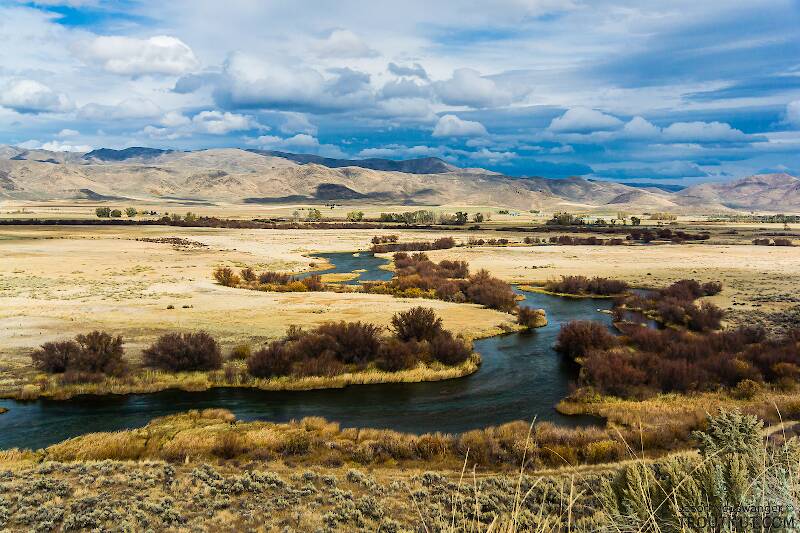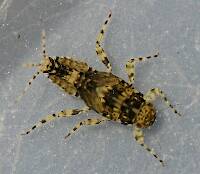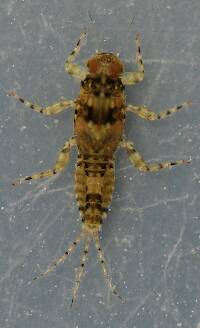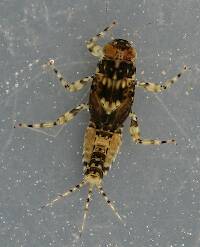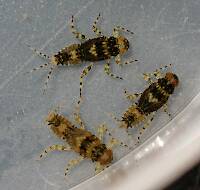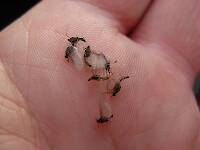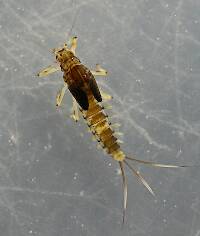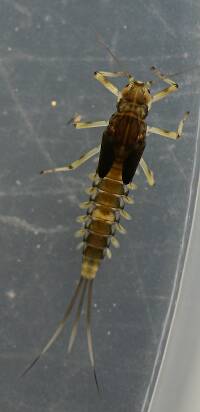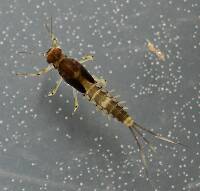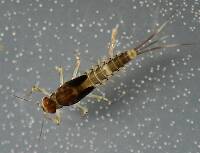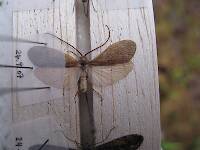
Blue-winged Olives
Baetis
Tiny Baetis mayflies are perhaps the most commonly encountered and imitated by anglers on all American trout streams due to their great abundance, widespread distribution, and trout-friendly emergence habits.
Featured on the forum

This one pretty clearly keys to Kogotus, but it also looks fairly different from specimens I caught in the same creek about a month later in the year. With only one species of the genus known in Washington, I'm not sure about the answer to this ID.

Troutnut is a project started in 2003 by salmonid ecologist Jason "Troutnut" Neuswanger to help anglers and
fly tyers unabashedly embrace the entomological side of the sport. Learn more about Troutnut or
support the project for an enhanced experience here.
Petern
Posts: 4
Posts: 4
Petern on Jul 27, 2013July 27th, 2013, 7:50 am EDT
A couple of weeks ago i was fishing on the Indian river in New York and discovered a very large insect on my trucks tire. It was so large i scooped it off with my trout net. It was about 4" long in the body with "antennae' 2"+. it managed to squirm through the net and released a stream of white liquid form its end. unfortunately I didn't get any pictures.
Taxon on Jul 27, 2013July 27th, 2013, 11:10 am EDT
Hi Peter-
Welcome aboard. There are no mayflies even approaching the body length describe. The largest N. American mayfly is the Ephemerid, Litobrancha recurvata, which attains a body length of ~40 mm (~ 1.5"). Leg pulling on this forum requires a tad more plausibility. :-)
Welcome aboard. There are no mayflies even approaching the body length describe. The largest N. American mayfly is the Ephemerid, Litobrancha recurvata, which attains a body length of ~40 mm (~ 1.5"). Leg pulling on this forum requires a tad more plausibility. :-)
Petern
Posts: 4
Posts: 4
Petern on Jul 27, 2013July 27th, 2013, 11:47 am EDT
thanks for the welcome! I've enjoyed troutnut for several months, but this is my first foray onto the forum. i assure you i am not pulling any legs. my first reaction to this bug was that it was a large dobson, but after seveeral minutes i felt the wing position and body shape where unmistakenly , although groetesquely exagerated, mayfly in character. wish i had a photo. any idea what it else it may be?
Taxon on Jul 27, 2013July 27th, 2013, 2:04 pm EDT
Peter-
What color was it? How many wings, 2 or 4? How were the held when not being used to fly, upright, out to the side, or folded back over the abdomen? Did it have any visible tails, and if so how many and how long were they? Did your body length estimate of 4" include the length of either antennae or tails?
any idea what it else it may be?
What color was it? How many wings, 2 or 4? How were the held when not being used to fly, upright, out to the side, or folded back over the abdomen? Did it have any visible tails, and if so how many and how long were they? Did your body length estimate of 4" include the length of either antennae or tails?
Petern
Posts: 4
Posts: 4
Petern on Jul 27, 2013July 27th, 2013, 2:27 pm EDT
the wings were upright. its color was greyish brown. two wings that i recall. the abdomen and thorax and head were in proportion of a mayfly. no tail. the "antenna' were thick protuberances, not wirey so i'm using the word because they didn't seem like mandibles. the total length was close to 6" i would say. i was parked near a large eddy on a fast section of river 1/4 mile below a dam.
Crepuscular on Jul 27, 2013July 27th, 2013, 3:23 pm EDT
The only insect in the NE that comes close to 6" would be a Phasmid. (Walking Stick). But even those are not quite that big. And the wings are certainly not held upright.
Troutnut on Jul 27, 2013July 27th, 2013, 9:47 pm EDT
Are you sure it wasn't a large dobsonfly, perhaps with an injury that put its wings at a funny angle? I've seen stoneflies with upright wings plenty of times (due to injuries) so I wouldn't be surprised if it happens to a dobsonfly once in a while.
Jason Neuswanger, Ph.D.
Troutnut and salmonid ecologist
Troutnut and salmonid ecologist
Petern
Posts: 4
Posts: 4
Petern on Jul 28, 2013July 28th, 2013, 2:03 am EDT
thanks for your input. i'm satisfied that it was probably the LARGEST specimen of an adult male dobson that i've ever seen, or can find record of on the "web". the posture of this bug was not typical to a dobson, and i beleive the abdomen was longer in proportion than a typical dobson. also the "mandibles" did not curve in.the injury theory may be right on the money, since it never flew away. whatever it was it was quite impressive insect to see!
Taxon on Jul 28, 2013July 28th, 2013, 7:13 am EDT
Hi Peter-
Some find this Aquatic Insect Recognition chart to be useful, as it allows one to compare the body lifestage outlines of most aquatic insect orders on a single screen. However, if your estimate of size (6 inches: 4 inch body plus 2 inch antennae) was not grossly exaggerated, what you saw it is more likely to have been some terrestrial insect.
Some find this Aquatic Insect Recognition chart to be useful, as it allows one to compare the body lifestage outlines of most aquatic insect orders on a single screen. However, if your estimate of size (6 inches: 4 inch body plus 2 inch antennae) was not grossly exaggerated, what you saw it is more likely to have been some terrestrial insect.
Quick Reply
Related Discussions
Topic
Replies
Last Reply
1
Aug 30, 2010
by GONZO
by GONZO

